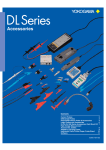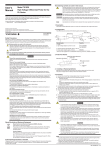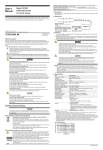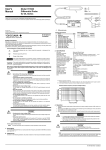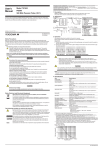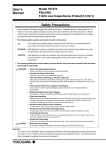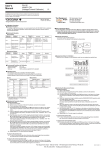Transcript
User's Manual 1.Overview 701935 Deskew Correction Signal Source The 701935 is a signal source used to correct the difference in the signal transfer time (skew, delay) between voltage and current probes. If using a Yokogawa oscilloscope equipped with the Auto Deskew function, the skew can be adjusted automatically. Note • When correcting the skew, use the falling edge of the waveform of the voltage and current signals that the 701935 outputs. • When connecting the current probe, match the direction of the arrows indicating the current direction of the 701935 and the current probe. • Securely connect the ground terminal (negative input on a differential probe, usually black) of the probe to the terminal of the voltage output terminal of the 701935). • Accurate correction may not be possible near objects generating strong magnetic fields such as a circuit with large current flowing or a transformer or near object generating strong electric fields such as a radio. Thank you for purchasing the Deskew Correction Signal Source (Model 701935). To use the full capabilities of the 701935, please read this manual thoroughly before beginning operation and use the 701935 correctly. For inquiries, please see PIM112-01E (attached). 2.External Dimensions and Names of Parts Name plate panel (Unit: mm) Rear View 69.2 To the power connector of the 701935 3rd Edition : December 2008 (YK) All Rights Reserved, Copyright © 2003, Yokogawa Electric Corporation Power connector The following symbols are used on this instrument. Warning: handle with care. Refer to the user’s manual or service manual. This symbol appears on dangerous locations on the instrument which require special instructions for proper handling or use. The same symbol appears in the corresponding place in the manual to identify those instructions. Functional ground terminal (do not use this terminal as a protective ground terminal.) WARNING Ground the Measurement Instrument Be sure to employ protective earth ground on the measurement instrument. Do Not Use in Locations of High Humidity To prevent electric shock, do not use the 701935 in locations of high humidity. Do Not Operate in an Explosive Atmosphere To prevent injury and fire, do not use the 701935 in locations where explosion or fire is possible in the presence of flammable liquids, vapors, and dust. Output voltage Output current Output frequency Fall time Operating temperature range Operation humidity range Storage temperature range Storage humidity range Supply voltage Approx. 15 kHz Approx. 15 ns 5 to 40°C 20 to 80% RH (no condensation) –20 to 60°C 20 to 80% RH (no condensation) +12 V ± 1 V (using the B9825MJ power cable, supplied from the probe power supply terminal provided by the DL Series Oscilloscope or the power supply (Model 700938 or 701934)) 150 mA or less 82.8 mm (W) × 32.5 mm (H) × 69.2 mm (D) (excluding protrusions) Approx. 150 g B9852MJ power cord 1 piece User’s Manual 1 piece (this manual) Complying standard •EN61326-1 Class A •EN61326-2-1 •EN55011 Class A, Group 1 •C-tick EN55011 Class A, Group 1 This product is a Class A (for commercial environment) product. Operation of this product in a residential area may cause radio interference in which case the user is required to correct the interference. Complying standard EN61326-1 Table 2 (for use in industrial locations) Approx. 5 V Emission Immunity Approx. –100 mA 4.Operating Procedure 1. Connect the power cord to the 701935 power connector. 2. Connect the other end of the power cord to the probe power supply of the DL Series Oscilloscope or the 700938 or 701934 Power Supply. 3. Connect the tip of the voltage probe (passive probe or differential probe) to the voltage output terminal of the 701935. 4. Connect the BNC connector end of the voltage probe (passive probe or differential probe) to the signal input terminal of the DL Series Oscilloscope. 5. Connect (Clamp) the current probe to the current output terminal of the 701935. 6. Connect the BNC connector end of the current probe to the signal input terminal of the DL Series Oscilloscope. Set the probe of the signal input terminal of the oscilloscope to the current probe setting (setting in which current-to-voltage conversion is possible). To the When using a passive probe in place of the differential Operating environment limitations CAUTION This product is a Class A (for industrial environments) product. Operation of this product in a residential area may cause radio interference in which case the user will be required to correct the interference. To the signal input terminal of the oscilloscope terminal To the probe power supply terminal* To the 5-V terminal 5-V terminal terminal To the signal input terminal of the oscilloscope See below for operating environment limitations. To the probe power supply terminal or power supply (Model 700938 or 701934) Output voltage/current (rectangular wave) Supply current External dimensions Weight Standard accessories CAUTION Do Not Damage the Current Output Terminal Do not damage the insulation cover of the current output terminal of the 701935. Do Not Short or Apply Voltage to the Output Terminal Do not short or apply external voltage to the output terminal. Doing so can cause damage to the 701935. Use the Correct Power Supply for the 701935 Use the probe power supply terminal provided by the YOKOGAWA DL Series Digital Oscilloscope (DL Series Oscilloscope) or the YOKOGAWA power supply (Model 700938 or 701934). Use the Correct Power Cord Use the power cord provided with the 701935 (Part No. B9852MJ). Ground the 701935 The electric potential of the terminal of the voltage output terminal is the same as that of the grounding terminal of the DL Series Oscilloscope to which it is connected. When Wiping off Dirt To wipe off dirt, use a dry, soft, clean cloth. Do not use volatile chemicals such as benzene or thinner for cleaning. Other Handling Precautions • Do not apply shock to the 701935 such as by dropping it or hitting it against another object. • Do not use the 701935 with the name plate panel facing down. • Since the 701935 is compact and light, it is easy to tilt the 701935 when voltage and current probes are connected (attached). Place the 701935 and probes on a flat even surface and be sure that the 701935 does not tilt. Current output terminal (The printed on the name plate panel is for matching the direction with the current probe arrow.) 3.Specifications Make sure to comply with the following safety precautions in order to prevent accidents such as an electric shock which impose serious health risks to the user and damage to the instrument. Power cord B9852MJ (Cord len.: 1.5 m) 2 The following safety precautions must be observed during all phases of operation. Yokogawa Electric Corporation assumes no liability for the customer’s failure to comply with these requirements. Read the user’s manual of the measurement instrument and have a thorough understanding of the specifications and handling of the instrument before using the 701935. 82.8 32.5 Safety Precautions Voltage output terminal terminal 5-V terminal 17.7 IM 701935-01E 3rd Edition Differential Probe 701921 Black (to ) Red (to 5-V) To the ground terminal Waste Electrical and Electronic Equipment To the probe power supply terminal* Waste Electrical and Electronic Equipment (WEEE), Directive 2002/96/EC (This directive is only valid in the EU.) This product complies with the WEEE Directive (2002/96/EC) marking requirement. This marking indicates that you must not discard this electrical/electronic product in domestic household waste. Product Category With reference to the equipment types in the WEEE directive Annex 1, this product is classified as a “Monitoring and Control instrumentation” product. Do not dispose in domestic household waste. When disposing products in the EU, contact your local Yokogawa Europe B. V. office. To the signal input terminal of the oscilloscope To the probe power supply terminal* Match the direction of the arrows indicating the current direction of the 701935 and the current probe. * If the oscilloscope is equipped with a probe power supply, connect to that terminal. Be sure not to exceed the probe power supply range. current signals that the 701935 outputs. For the setup procedure of the oscilloscope, see the manual that came with the oscilloscope. 8. Using the deskew function of the DL Series Oscilloscope, correct the signals so that the starting sections of the falling edges of the waveforms match. Example of Skew Correction When the Waveform Acquisition Mode Is Set to Averaging on the DL Series Oscilloscope Improper handling or use can lead to injury to the user or damage to the instrument. This symbol appears on the instrument to indicate that the user must refer to the user’s manual for special instructions. The same symbol appears in the corresponding place in the user’s manual to identify those instructions. In the manual, the symbol is used in conjunction with the word “WARNING” or “CAUTION.” Before skew correction WARNING Calls attention to actions or conditions that could cause serious or fatal injury to the user, and precautions that can be taken to prevent such occurrences. 701935 (Deskew Correction Signal Source) 7. On the DL Series Oscilloscope, observe the falling edges of the waveforms of voltage and The Following Symbols are Used in this Manual. Current probe (701932, 701933, 701928, or 701989) Power cord B9852MJ Voltage signal Current signal After skew correction Starting section of the falling edge CAUTION Calls attentions to actions or conditions that could cause light injury to the user or damage to the instrument or the user’s data, and precautions that can be taken to prevent such occurrences. Note Calls attention to information that is important for proper operation of the instrument. IM 701935-01E

